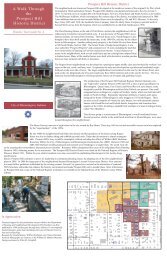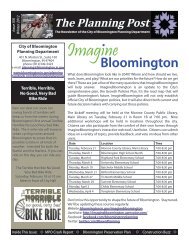Peak Oil Task Force Report - City of Bloomington - State of Indiana
Peak Oil Task Force Report - City of Bloomington - State of Indiana
Peak Oil Task Force Report - City of Bloomington - State of Indiana
Create successful ePaper yourself
Turn your PDF publications into a flip-book with our unique Google optimized e-Paper software.
REVIEW OF THE CURRENT SITUATION: PAVING THE WAY<br />
Road Infrastructure and its Influence on<br />
Development<br />
The growth <strong>of</strong> an expansive road network has<br />
had a transformative effect on <strong>Bloomington</strong>’s<br />
built environment for the past two decades. An<br />
aphorism attributed to industrial designer<br />
Norman Bel Geddes, who designed General<br />
Motor’s Futurama exhibit for the 1931 World’s<br />
Fair, stated “the highway should not impress<br />
upon the city, nor should the city impress<br />
upon the highway.” The traditional practice <strong>of</strong> running connecting pikes and roads through<br />
the centers <strong>of</strong> the communities they connected was deemed to be no longer appropriate<br />
because most highway traffic would not be expected to be destined for the communities<br />
through which the highway ran. It was expected to be bypass traffic which, if routed<br />
through the community, would only add to congestion and not commerce. Therefore, it<br />
was thought best to allow it to pass by communities rather than through them.<br />
<strong>Bloomington</strong> was not immune from this bypass logic. <strong>State</strong> Road 37 used to come through<br />
<strong>Bloomington</strong> by way <strong>of</strong> Cascades Park. The park was a Depression‐era project <strong>of</strong><br />
considerable civic utility. Community leaders at the time believed that the experience <strong>of</strong><br />
entering (or leaving) <strong>Bloomington</strong> would be greatly enhanced if the road wound through a<br />
park – as it still does. However, by the 1960s Bel Geddes’ sentiment had deeply pervaded<br />
the highway engineering mindset and, when calls were made to help deal with the<br />
“congestion” on <strong>State</strong> Road 37, it was natural to look at bypassing the city as one part <strong>of</strong> a<br />
comprehensive solution. By the early 1970s the road had been divided, four‐laned, and<br />
now took a route not through the city, but far <strong>of</strong>f to its west side, through an almost entirely<br />
rural landscape.<br />
<strong>Report</strong> <strong>of</strong> the <strong>Bloomington</strong> <strong>Peak</strong> <strong>Oil</strong> <strong>Task</strong> <strong>Force</strong><br />
The SR 37/SR 46 “Exchange” constructed in anticipation <strong>of</strong> building a<br />
new terrain highway through much <strong>of</strong> Southern <strong>Indiana</strong>’s farmland and<br />
greenspace in the interest <strong>of</strong> increased commodity transport by truck.<br />
92









